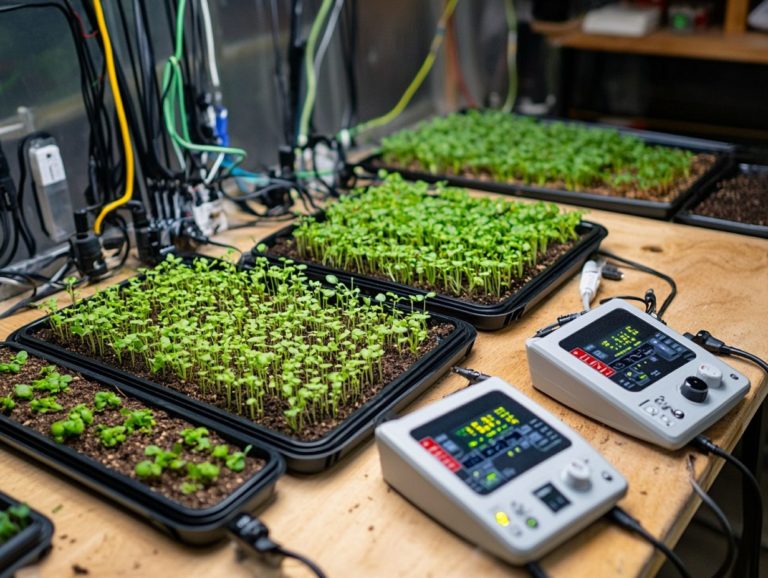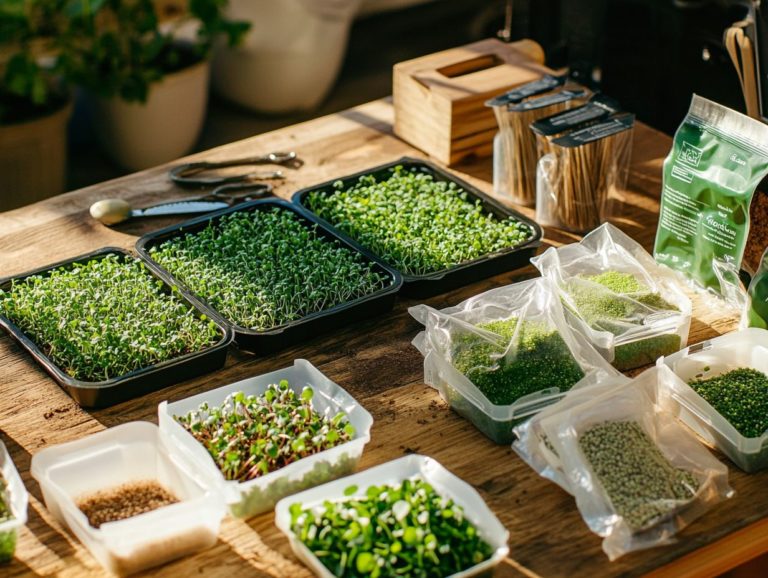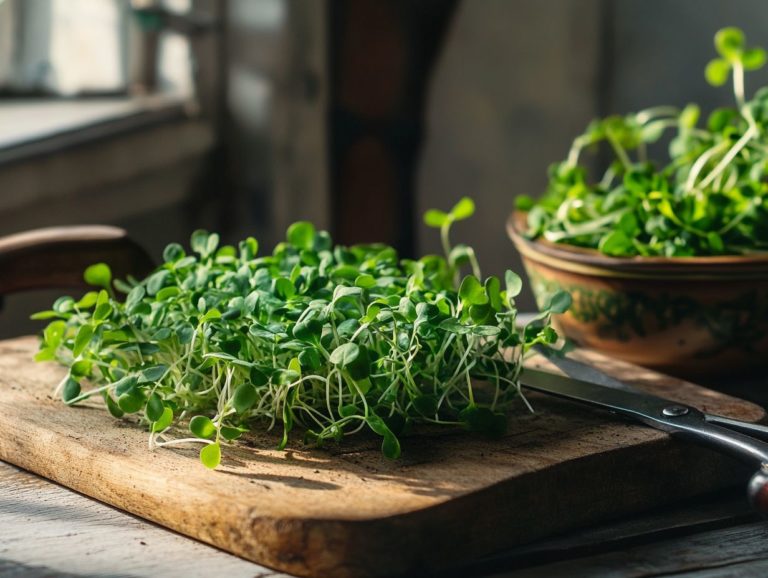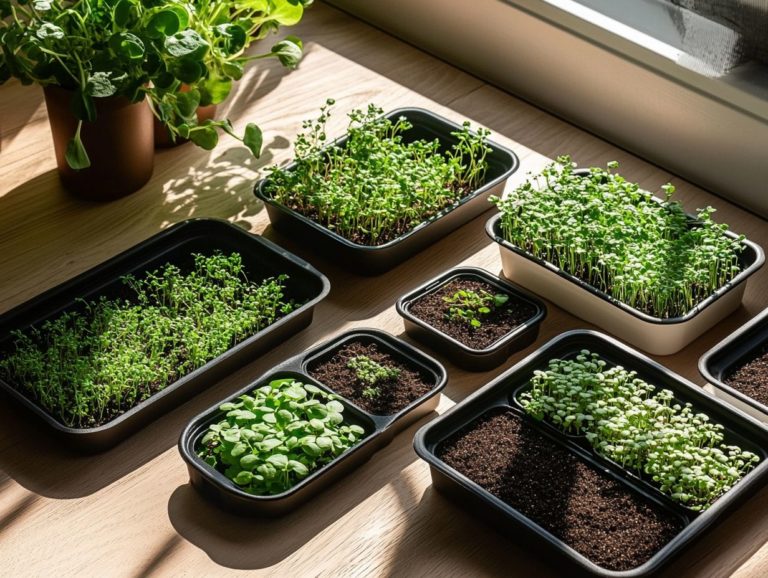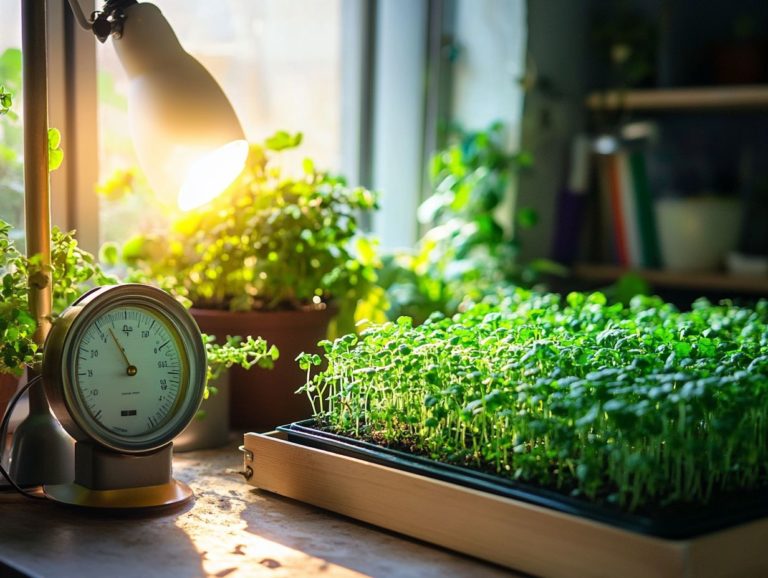How to Create a Microgreen Equipment Inventory
Microgreens are more than just a culinary trend; they re a vibrant adventure for your health and garden!
Explore the numerous benefits of cultivating microgreens, from their impressive health advantages to the savings they bring to your grocery budget.
This guide outlines the essential equipment you’ll need to grow microgreens successfully, allowing you to create a thorough inventory list.
You ll find practical tips for maintaining and replenishing your supplies, ensuring that your microgreen garden flourishes beautifully.
Whether you’re just starting out or you ve got a green thumb, this guide equips you with the insights to elevate your microgreen growing journey.
Contents
- Key Takeaways:
- Benefits of Growing Microgreens
- Essential Equipment for Growing Microgreens
- Creating an Inventory List
- Tips for Maintaining and Replenishing Inventory
- Frequently Asked Questions
- What is a microgreen equipment inventory?
- Why is it important to create a microgreen equipment inventory?
- How do I start creating a microgreen equipment inventory?
- What are some common equipment used for growing microgreens?
- How often should I update my microgreen equipment inventory?
- Can I use household items for growing microgreens instead of purchasing new equipment?
Key Takeaways:
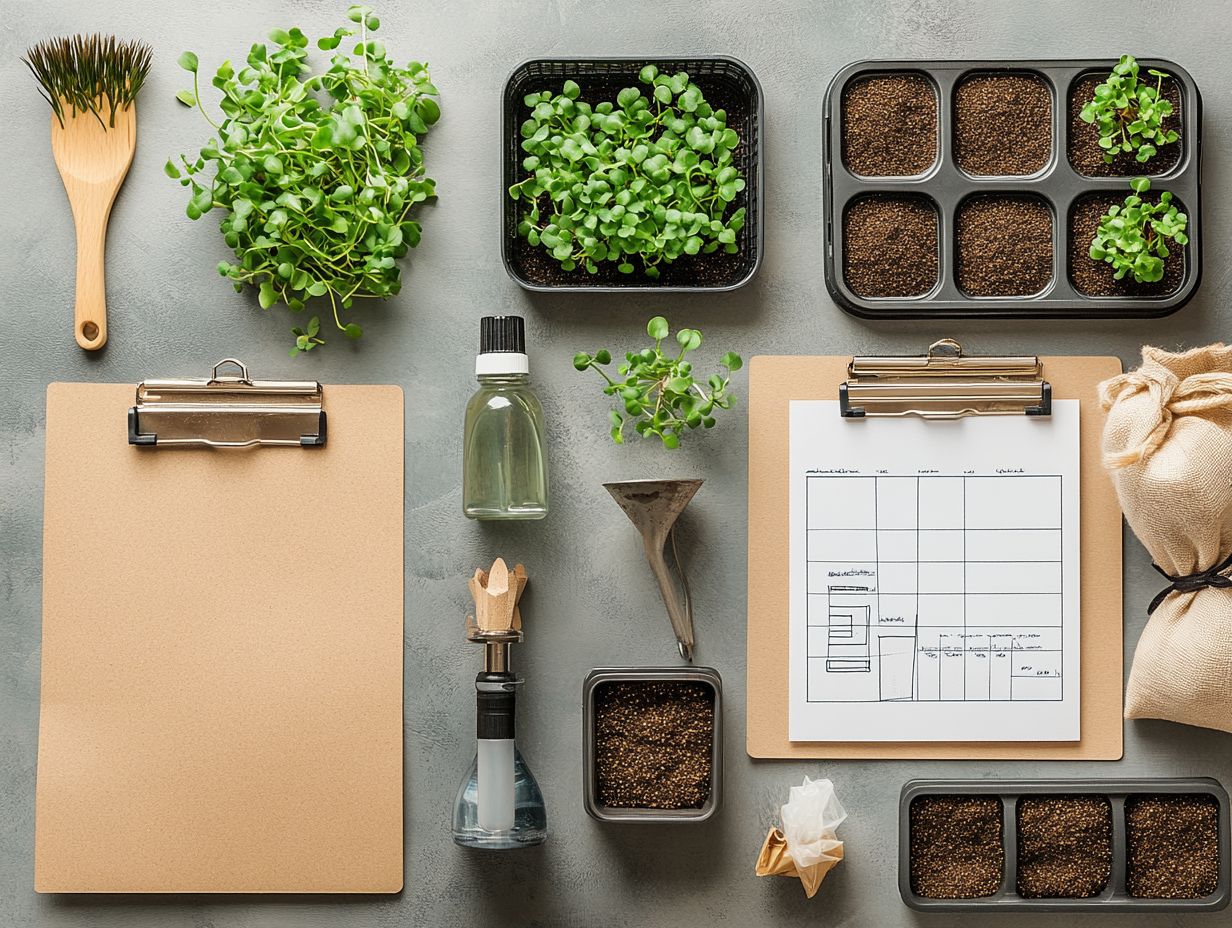
- Invest in essential equipment for efficient microgreen cultivation, such as growing trays, lighting systems, and watering systems.
- Create an inventory list to organize and track your microgreen equipment, ensuring you have what you need for successful growth.
- Maintain and replenish your inventory regularly by properly storing and replacing equipment, saving you time and money in the long run.
What are Microgreens?
Microgreens are young, edible plants that you can harvest at an early stage, celebrated for their vibrant colors, intense flavors, and impressive nutritional profiles. Their popularity has skyrocketed in recent years, not just for culinary delights but also for their myriad health benefits, making them a staple in many diets.
This growing interest has given rise to a flourishing microgreens business landscape, where entrepreneurs focus on a variety of crops, like broccoli and more, to satisfy the increasing local demand. Companies such as True Leaf Market have stepped up as leaders in this space, offering invaluable resources for those eager to dive into microgreens farming and health enthusiasts alike.
These tiny green wonders are typically harvested within 7 to 21 days after germination, ensuring they are packed with high concentrations of vitamins and antioxidants. As urban farming gains traction, many city dwellers are discovering the joy of cultivating microgreens at home, relishing the experience of growing their own food while contributing to local sustainability efforts.
Community gardens often host workshops. These gatherings help enthusiasts share tips on how to grow microgreens and the health benefits of these remarkable plants. With a delightful array of varieties available ranging from arugula to radish and beet greens there s something to please every palate, reinforcing their essential role in modern healthy eating.
Benefits of Growing Microgreens
Growing microgreens presents a wealth of benefits that extend beyond personal health and nutrition. You ll find that they make meaningful contributions to both the local community and the economy, fueled by an ever-increasing market demand.
As both individuals and businesses come to appreciate their remarkable potential, microgreens are becoming essential players in the health-conscious food movement.
Nutritional Value and Cost Savings
Microgreens are a nutritional powerhouse. They also offer significant cost savings for you and your business, making them a wise choice.
Research shows that these tiny greens can pack up to 40 times more vitamins and minerals than fully grown vegetables. This boosts their appeal in health-conscious markets.
Take broccoli, kale, and radish microgreens, for example. They re loaded with essential nutrients like vitamin C, vitamin K, and antioxidants, far outshining traditional vegetables that often lose some of their goodness during storage and cooking.
Growing microgreens requires fewer resources, resulting in lower costs and faster harvest times. This efficiency is a win-win for you, whether you’re aiming to enhance your diet or a business looking to offer fresh, high-quality produce without emptying your wallet.
In the end, the accessibility and nutritional density of microgreens make them a compelling alternative to conventional vegetables.
Essential Equipment for Growing Microgreens
To successfully cultivate microgreens, you’ll need essential equipment that guarantees optimal growing conditions and high-quality yields. This equipment not only supports the growth process but also plays a vital role in effective quality control, crucial for upholding the standards expected in the microgreens business.
Growing Trays
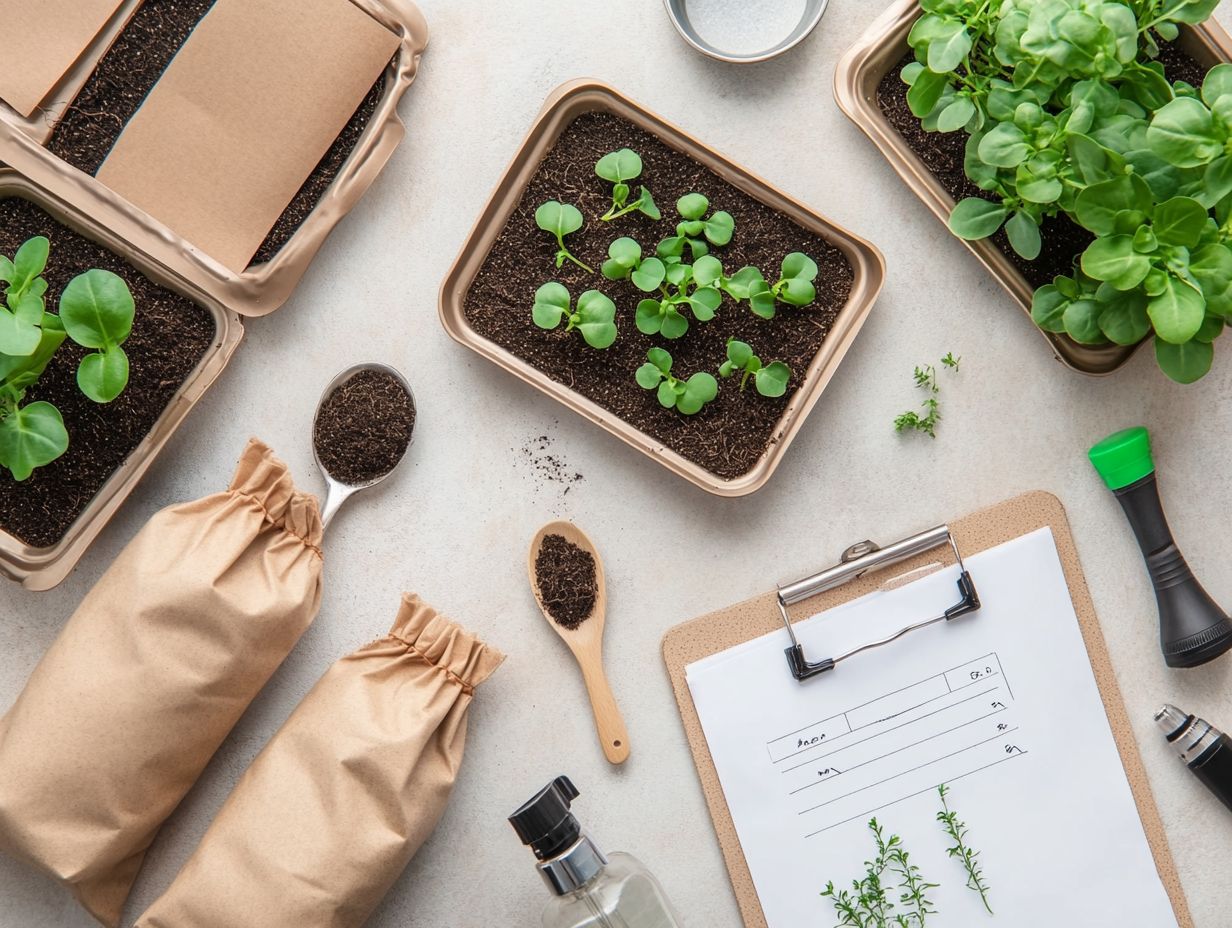
Growing trays are vital for microgreens, providing the support and space needed for optimal growth. Choosing the right trays ensures proper drainage and aeration two key factors that can make or break your microgreens business.
You’ll find various types of growing trays on the market, made from materials like plastic, wood, and even biodegradable options. Each material presents unique benefits. Sizes vary too, from small flats perfect for home growers to larger, commercial-grade trays designed for extensive operations.
Consider the specific needs of your microgreens; some flourish in shallow trays, while others require deeper containers to accommodate their root development.
Pay attention to your environment. Trays with good drainage holes help prevent waterlogging, encouraging robust root growth. By aligning the right trays with your specific crops and conditions, you can significantly enhance both yield and quality.
Lighting Systems
Lighting systems are essential for growing microgreens and significantly impact how plants turn light into food. By using LED lights, you enhance growth efficiency, providing the precise spectrum of light your microgreens need at various growth stages.
Proper lighting boosts germination rates, promotes vibrant color, and increases nutrient density key ingredients for flavor-packed microgreens. While fluorescent and high-intensity discharge (HID) lights are popular alternatives, they often come with higher energy costs and increased heat production. In contrast, LED lights are energy-efficient and emit less heat, making them ideal for indoor environments where temperature control is vital.
These lights can be easily configured to deliver specific wavelengths, ensuring that different varieties of microgreens receive the optimal light conditions they crave. Choose the right lighting system to ensure a bountiful harvest!
Growing Medium
The choice of growing medium is crucial for cultivating healthy microgreens, as it directly influences water retention, aeration, and nutrient availability. Coconut coir is a favored option among microgreens farmers due to its sustainability and impressive moisture retention qualities.
However, it s not the only option. Peat moss is well-regarded for its high acidity and moisture-holding capabilities, making it ideal for acid-loving plants, but its sustainability raises concerns.
Rock wool excels in aeration and drainage but may require close monitoring of nutrient levels for optimal growth. Then there s vermiculite, celebrated for its lightweight nature and ability to retain water without becoming overly saturated.
Each growing medium uniquely influences growth rates and the overall health of your microgreens. Carefully consider these factors based on your specific needs.
Get started today and enjoy fresh, nutritious microgreens at home!
Seeds and Seedling Trays
Selecting high-quality seeds and the right seedling trays is crucial for your success in growing microgreens. These factors significantly influence germination rates and the overall quality of your yield. Seed quality is crucial for the vitality of your microgreens, making it essential to invest in reputable sources.
Choosing seeds specifically bred for microgreens ensures that they sprout quickly and consistently. Varieties like arugula or radish offer remarkable flavor profiles, especially when sourced from certified suppliers.
Don’t underestimate the importance of seedling trays. These trays provide the drainage and air circulation needed for healthy root development. Selecting the right tray size prevents overcrowding and allows each microgreen ample space to flourish.
By focusing on both seed quality and the ideal growing environment, you can significantly elevate your microgreen harvests. Additionally, learning how to create a microgreen storage schedule will ensure your harvest stays fresh. Start selecting your seeds today for a successful harvest!
Watering System
An effective watering system is essential for maintaining the health of your microgreens, as proper moisture levels are crucial for germination (the process of seeds sprouting) and growth. By implementing a reliable watering system, you can ensure consistency and quality control in your microgreens business.
You have a range of options at your disposal, from manual methods like spray bottles and watering cans to advanced automated systems that utilize timers and drip irrigation. When selecting the right approach, consider the frequency of watering, which can vary depending on the specific type of microgreens you’re growing. For a comprehensive guide, check out how to create a microgreen variety garden.
Don’t overlook water quality. Using clean, chlorine-free water is vital to prevent mold and support robust growth. Bottom watering and using humidity domes can help create an optimal environment, ensuring that your microgreens thrive beautifully. For more information, check out this guide on how to store different microgreen varieties.
Other Necessary Tools
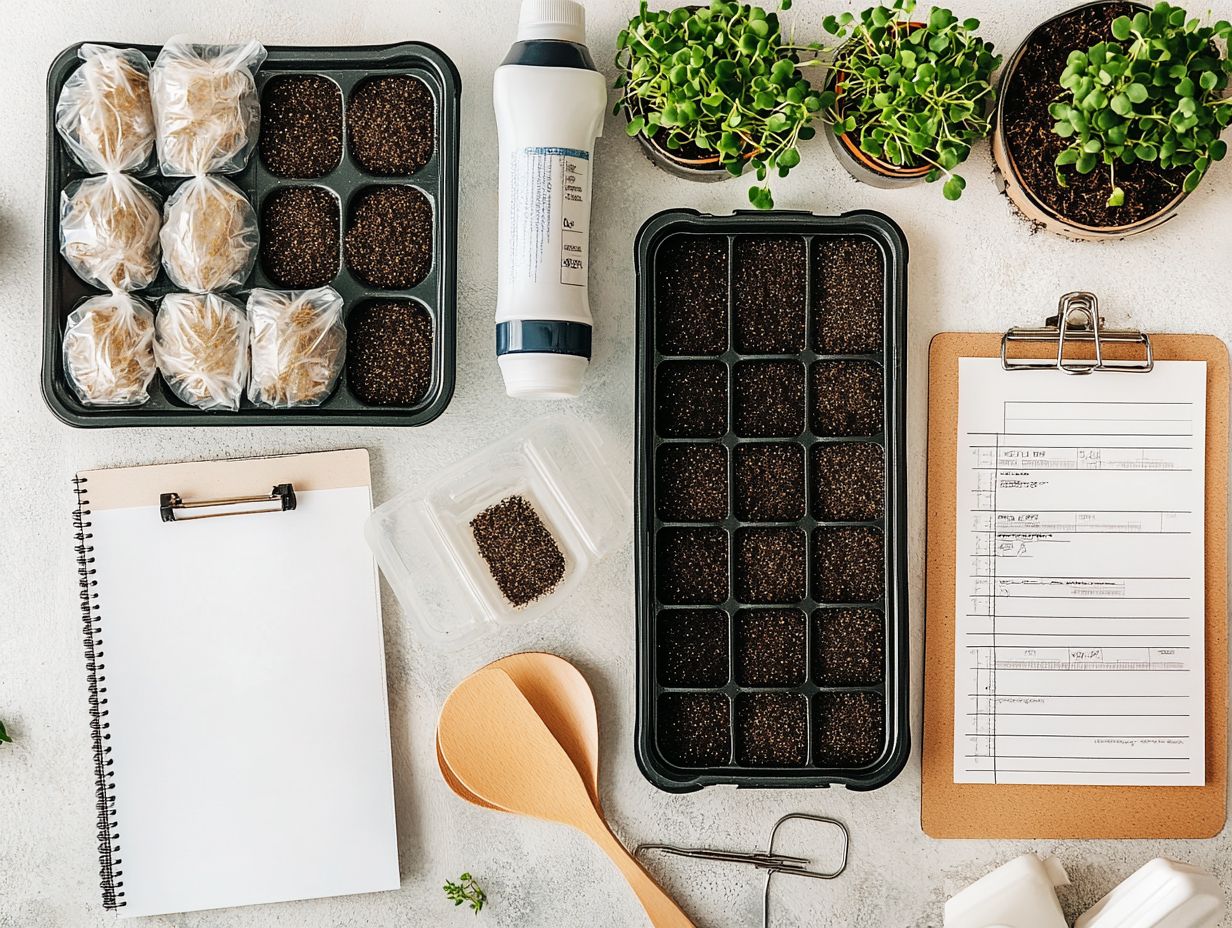
In addition to the essential equipment for growing microgreens, several critical tools can elevate your cultivation process and boost efficiency. These tools include temperature and humidity monitors and dehumidifiers, which are game-changers for your growing setup!
For instance, LED grow lights mimic natural sunlight, enabling photosynthesis even in low-light situations crucial for fostering healthy growth. Soil moisture sensors allow you to monitor water levels closely, helping you avoid the common misstep of under- or over-watering your microgreens. If you’re interested in expanding your gardening skills, check out this guide on how to start a microgreen garden for beginners. Airflow systems are vital for ensuring proper ventilation, which reduces the risk of mold and mildew while maintaining consistent temperature levels.
Opting for trays with drainage holes is another smart move, as they prevent excess water from accumulating, thus protecting the delicate root systems of your microgreens. For those interested in expanding their knowledge, learning how to grow microgreens in a greenhouse can further enhance your gardening skills. Together, these tools create the ideal conditions for thriving crops, promoting robust growth and maximizing your yields.
Creating an Inventory List
Developing an inventory list is an essential step in launching a successful microgreens business. It helps you keep track of vital equipment and supplies and streamlines your financial management.
This meticulous organization ensures that you stay compliant with local regulations while effectively meeting market demands.
Organizing and Tracking Equipment
Organizing and tracking your equipment is crucial for the seamless operation of your microgreens business. This ensures that all necessary items are readily available when you need them. An efficient tracking system aids in inventory management and helps you stay on top of timely equipment maintenance.
To accomplish this, consider utilizing software applications like QuickBooks or Excel. These tools allow you to create detailed inventories, set reminders for maintenance checks, and generate reports for easy analysis. Implementing a consistent labeling system for your items, along with regular audits, will significantly enhance visibility and accountability.
Integrating barcode scanning technology can take this a step further, simplifying equipment management. By dedicating time to maintain organized records and leveraging these tools, you can streamline your operations and minimize the risk of equipment-related setbacks.
Tips for Maintaining and Replenishing Inventory
Maintaining and replenishing your inventory is crucial for the seamless operation of your microgreens business. It allows you to meet customer demands and ensures quality control.
Develop a systematic approach to inventory management to minimize disruptions in your supply chain. This keeps your business running smoothly and efficiently.
Proper Storage and Replacement Strategies
Implementing proper storage and replacement strategies is essential for preserving the quality of your microgreens and ensuring their longevity. By utilizing the right storage conditions, you can prevent spoilage and enhance quality control.
Maintain optimal temperature and humidity levels; ideal conditions typically range from 35 F to 45 F, with a humidity level around 40-50%. This balance is key to keeping your greens crisp and fresh.
Consider using breathable containers or perforated bags to facilitate airflow. This helps reduce moisture buildup that can lead to decay. To ensure a consistent supply, think about staggering your sowing schedule, allowing different batches to mature simultaneously.
Regularly monitor your supplies and implement a first-in-first-out (FIFO) system. This guarantees that your customers receive only the finest quality microgreens. For those looking to start growing these nutritious greens, check out this guide on how to create a microgreen grow kit.
Frequently Asked Questions
What is a microgreen equipment inventory?
A microgreen equipment inventory is a list of all the tools, supplies, and equipment needed to grow microgreens. It helps you keep track of your resources and plan for future purchases.
Why is it important to create a microgreen equipment inventory?
Creating a microgreen equipment inventory ensures that you have all the necessary tools and supplies to successfully grow microgreens. It helps you manage your budget and avoid overspending on unnecessary items.
How do I start creating a microgreen equipment inventory?
Start by making a list of all the equipment you currently have. This includes trays, grow lights, seedling soil, and other necessary supplies. Then, identify any missing items that you need to purchase.
What are some common equipment used for growing microgreens?
- Grow trays
- Grow lights
- Heat mats
- Seedling soil
- Watering cans
- Scissors
- Digital scale
- Measuring spoons
- Spray bottle
How often should I update my microgreen equipment inventory?
Update your microgreen equipment inventory every month to stay on top of your supplies! This will help you track any changes in your supplies and budget accordingly.
Can I use household items for growing microgreens instead of purchasing new equipment?
Yes, you can use household items such as plastic containers, egg cartons, and even old shoeboxes as alternative containers for growing microgreens. Make sure they are properly cleaned and sterilized before use to avoid contamination.

